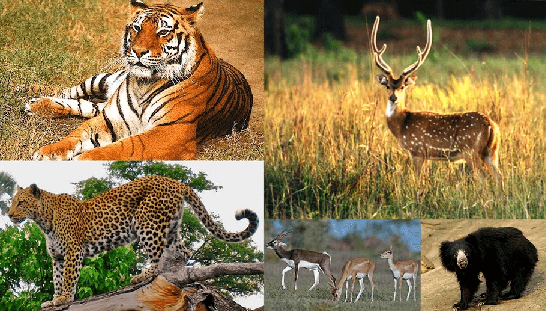Class 10 Geography Chapter 2 Extra Question Answers - Forest and Wildlife Resources (Deducted from CBSE 2021-22 examination)
Q1. Write any three measures to conserve the ecosystem?
Ans: Three measures to conserve the ecosystem are:
- Reserve forests and plant more trees, especially in areas affected by deforestation.
- Protect wildlife through laws and public awareness campaigns.
- Initiate projects aimed at saving endangered species of plants and animals.
Q2. Explain any three methods of forest conservation adopted by the government after independence.

Ans: The government has adopted several methods to conserve forests after independence:
- Forests are classified into three types: Reserved forests, Protected forests, and Unclassed forests. This classification clarifies which activities are permitted in each type.
- To protect wildlife, various laws have been enacted, such as the Indian Wildlife (Protection) Act of 1972. Many national parks and wildlife sanctuaries have also been established by central and state governments.
- The government has initiated programs like Van Mahotsava to raise awareness about the importance of forests among the public.
Q3. Give three reasons why we need to save the biodiversity of our planet?
Ans: We must conserve or save the biodiversity of our planet because:
- If we do not protect forests, entire wildlife populations will be at risk, disrupting the vital food cycle.
- The loss of biodiversity is linked to a decline in cultural diversity, which can marginalise and impoverish many tribal and forest communities.
- Women are particularly affected by biodiversity loss, as they often gather food, fuel, and water for their families.
Q4. What has been the contribution of the Indian Wildlife (Protection) Act in protecting habitats in India. Explain.
Ans: The Indian Wildlife (Protection) Act, enacted in 1972, plays a crucial role in safeguarding habitats in India. Its key contributions include:
- Establishing a comprehensive list of protected species across the country.
- Implementing a ban on hunting to help endangered species recover.
- Providing legal protection to vital habitats.
- Restricting trade in wildlife to prevent exploitation.
As a result, both central and state governments have:
- Created numerous national parks and wildlife sanctuaries.
- Launched projects aimed at protecting endangered animals, such as the tiger and the one-horned rhinoceros.
- Extended legal protection to various species, including the Asiatic lion and the Indian elephant.
Q5. Write any three effective practices towards conserving forests and wildlife.
Ans: Effective Practices for Conserving Forests and Wildlife are as follows:
- Establishing National Parks and Wildlife Sanctuaries: These areas are legally protected, prohibiting activities like hunting and deforestation.
- Launching Conservation Projects: Initiatives like Project Tiger focus on protecting endangered species and their habitats.
- Community Involvement: Engaging local communities in conservation efforts, such as the Chipko and Beej Bachao movements, has proven highly effective.
Q6. Write a brief note on ‘Project Tiger’.

Ans: Project Tiger was launched in 1973 to protect the declining tiger population in India. Key points include:
- Initial success saw the tiger population rise from 1,827 in 1973 to 4,334 in 1989.
- By 1993, the population decreased to 3,600 due to threats like poaching and habitat loss.
- India has 27 tiger reserves covering 37,761 sq km.
- Notable reserves include Corbett National Park, Sunderbans National Park, and Bandhavgarh National Park.
Tiger conservation also helps preserve diverse ecosystems and supports biodiversity.
Q7. Why is conservation of forest and wildlife necessary? In what way have conservation projects changed in recent years?
Ans:
- Conservation of forests and wildlife is essential for sustainable development, as it protects vital ecosystems.
- It helps maintain ecological diversity and supports our life systems, including water, air, and soil.
- Conservation also safeguards the genetic diversity of plants and animals, promoting species growth and breeding.
In recent years, conservation projects have shifted focus to biodiversity as a whole, rather than just a few species. There is now a greater emphasis on finding diverse conservation methods, including the protection of insects.
Q8. With the help of three examples show how communities have carried out conservation of flora and fauna in India.
Ans:
In Sariska Tiger Reserve, Rajasthan, villagers have successfully opposed mining activities by referencing the Wildlife Protection Act. They actively protect their forests.
In Alwar district, residents of five villages have designated 1,200 hectares of forest as the Bhairodev Dakav Sanctuary. They established their own rules to prohibit hunting and safeguard wildlife.
The Chipko movement in the Himalayas has effectively halted deforestation and promoted community-led afforestation using native species.
Q9. Explain any two famous movements for the protection of forests.
Ans: The Chipko movement in the Himalayas has effectively resisted deforestation in Uttarakhand. It has demonstrated that community-led afforestation using native species can thrive. Groups like the Beej Bachao Andolan and Navdanya have shown that diverse crop production is possible without synthetic chemicals.
The Joint Forest Management (JFM) programme, established in 1988, encourages local communities to manage and restore degraded forest areas. This initiative relies on forming local groups that collaborate with the forest department to protect these lands.
Q10. What is bio-diversity? Why is bio-diversity important for human life?
Ans: Biodiversity refers to the variety of life on Earth, including all wildlife and cultivated species. It encompasses a wide range of forms and functions, all interconnected through various interdependencies.
Its importance for human life includes:
- Providing essential resources such as food, clean air, and water.
- Supporting ecosystems that regulate our environment.
- Maintaining the health of our planet, which is vital for our survival.
Without biodiversity, human life would be unsustainable.
|
66 videos|614 docs|79 tests
|
FAQs on Class 10 Geography Chapter 2 Extra Question Answers - Forest and Wildlife Resources (Deducted from CBSE 2021-22 examination)
| 1. What are the main types of forests found in India? |  |
| 2. Why are forests important for wildlife conservation? |  |
| 3. How do deforestation and habitat loss affect wildlife? |  |
| 4. What measures can be taken to conserve forest and wildlife resources? |  |
| 5. What role do forests play in combating climate change? |  |






















